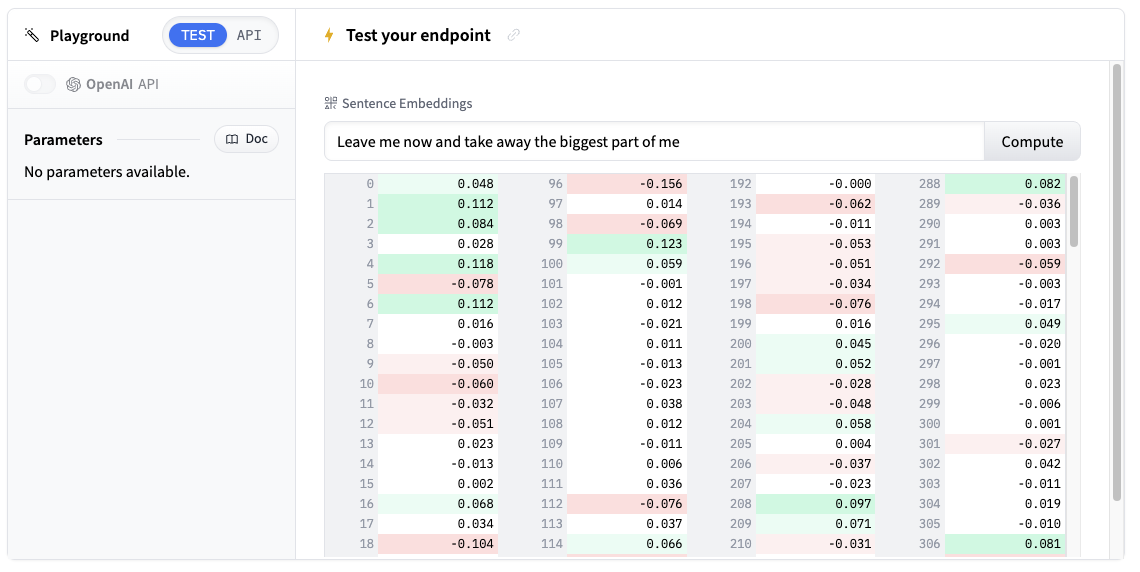推理端點(專用)文件
使用資料集構建嵌入管道
並獲得增強的文件體驗
開始使用
使用資料集構建嵌入管道
本教程將引導您部署嵌入端點並構建一個 Python 指令碼,以高效處理帶有嵌入的資料集。我們將使用強大的 Qwen/Qwen3-Embedding-4B 模型為您的資料建立高質量的嵌入。
本教程側重於建立可用於生產的指令碼,該指令碼可以使用 **文字嵌入推理 (TEI)** 引擎處理任何資料集並新增嵌入,以最佳化效能。
建立您的嵌入端點
首先,我們需要建立一個針對嵌入最佳化的推理端點。
首先導航到 Inference Endpoints UI,登入後您應該會看到一個用於建立新推理端點的按鈕。單擊“New”按鈕。

從那裡,您將被定向到目錄。模型目錄包含流行的模型,這些模型具有經過調優的配置,可以一鍵部署。您可以搜尋嵌入模型或建立自定義端點。

在本教程中,我們將使用推理端點模型目錄中提供的 Qwen3-Embedding-4B 模型。請注意,如果它不在目錄中,您可以透過輸入模型倉庫 ID `Qwen/Qwen3-Embedding-4B`,將其作為自定義端點從 Hugging Face Hub 部署。
對於嵌入模型,我們建議使用:
- GPU:NVIDIA、T4、L4 或 A10G,以獲得良好效能。
- 例項大小:x1(足以滿足大多數嵌入工作負載)
- 自動擴縮:啟用縮放到零,以便在不使用端點時將其切換到暫停狀態,從而節省成本。
- 超時:設定 10 分鐘的超時時間以避免長時間執行的請求。您應該根據預期如何使用端點來定義超時。
如果您正在尋找計算要求較低的模型,可以使用 sentence-transformers/all-MiniLM-L6-v2 模型。
Qwen3-Embedding-4B 模型將自動使用 **文字嵌入推理 (TEI)** 引擎,該引擎提供最佳化的推理和自動批處理。
點選“建立端點”以部署您的嵌入服務。

這可能需要大約 5 分鐘來初始化。
測試您的端點
推理端點執行後,您可以在遊樂場中直接測試它。它接受文字輸入並返回高維向量。

嘗試輸入一些示例文字,例如“機器學習正在改變我們處理資料的方式”,並檢視嵌入輸出。
獲取您的端點詳細資訊
要以程式設計方式使用您的端點,您需要從端點的 概述 中獲取這些詳細資訊:
- 基本 URL:`https://<endpoint-name>.endpoints.huggingface.cloud/v1/`
- 模型名稱:您的端點名稱
- 令牌:您從 設定 中獲取的 HF 令牌

構建嵌入指令碼
現在,讓我們逐步構建一個處理帶有嵌入的資料集的指令碼。我們將它分解成邏輯塊。
步驟 1:設定依賴項和匯入
我們將使用 OpenAI 客戶端連線到端點,並使用 `datasets` 庫載入和處理資料集。因此,我們首先安裝所需的包:
pip install datasets openai
然後,在一個新的 Python 檔案中設定您的匯入:
import os
from datasets import load_dataset
from openai import OpenAI步驟 2:配置連線
根據您上一步收集的詳細資訊,設定連線到推理端點的配置。
# Configuration
ENDPOINT_URL = "https://your-endpoint-name.endpoints.huggingface.cloud/v1/" # Endpoint URL + version
HF_TOKEN = os.getenv("HF_TOKEN") # Your Hugging Face Hub token from hf.co/settings/tokens
# Initialize OpenAI client for your endpoint
client = OpenAI(
base_url=ENDPOINT_URL,
api_key=HF_TOKEN,
)您的 OpenAI 客戶端現在已配置為連線到您的推理端點。如需進一步閱讀,您可以查閱文字嵌入客戶端文件 此處。
步驟 3:建立嵌入函式
接下來,我們將建立一個函式來處理批次的文字並返回嵌入。
def get_embeddings(examples):
"""Get embeddings for a batch of texts."""
response = client.embeddings.create(
model="your-endpoint-name", # Replace with your actual endpoint name
input=examples["context"], # In the squad dataset, the text is in the "context" column
)
# Extract embeddings from response objects
embeddings = [sample.embedding for sample in response.data]
return {"embeddings": embeddings} # datasets expects a dictionary with a key "embeddings" and a value of a list of embeddings`datasets` 庫將向我們的函式傳遞一批來自資料集的示例,作為批次值的字典。鍵將是我們要嵌入的列的名稱,值將是該列的值列表。
步驟 4:載入和處理您的資料集
載入您的資料集並應用嵌入函式
# Load a sample dataset (you can replace this with your own)
dataset = load_dataset("squad", split="train[:100]") # Using first 100 examples for demo
# Process the dataset with embeddings
dataset_with_embeddings = dataset.map(
get_embeddings,
batched=True,
batch_size=10, # Process in small batches to avoid timeouts
desc="Adding embeddings",
)資料集庫的 `map` 函式經過最佳化,可自動為我們批處理行。推理端點還可以根據批次大小的需求進行擴充套件,因此為了獲得最佳效能,您應該根據推理端點的配置校準批次大小。
例如,為您的模型選擇儘可能高的批處理大小,並將批處理大小與推理端點在 `max_concurrent_requests` 中的配置同步。
步驟 5:儲存並分享您的結果
最後,讓我們將嵌入式資料集本地儲存或推送到 Hugging Face Hub
# Save the processed dataset locally
dataset_with_embeddings.save_to_disk("./embedded_dataset")
# Or push directly to Hugging Face Hub
dataset_with_embeddings.push_to_hub("your-username/squad-embeddings")後續步驟
幹得好!您現在已經構建了一個可以處理任何資料集的嵌入管道。以下是完整的指令碼:
點選檢視完整指令碼
import os
from datasets import load_dataset
from dotenv import load_dotenv
from openai import OpenAI
load_dotenv()
# Configuration
ENDPOINT_URL = "https://your-endpoint-name.endpoints.huggingface.cloud/v1/"
HF_TOKEN = os.getenv("HF_TOKEN")
# Initialize OpenAI client for your endpoint
client = OpenAI(
base_url=ENDPOINT_URL,
api_key=HF_TOKEN,
)
def get_embeddings(examples):
"""Get embeddings for a batch of texts."""
response = client.embeddings.create(
model="your-endpoint-name", # Replace with your actual endpoint name
input=examples["context"],
)
# Extract embeddings from response
embeddings = [sample.embedding for sample in response.data]
return {"embeddings": embeddings}
# Load a sample dataset (you can replace this with your own)
print("Loading dataset...")
dataset = load_dataset("squad", split="train[:1000]") # Using first 1000 examples for demo
# Process the dataset with embeddings
print("Processing dataset with embeddings...")
dataset_with_embeddings = dataset.map(
get_embeddings,
batched=True,
batch_size=10, # Process in small batches to avoid timeouts
desc="Adding embeddings",
)
# Save the processed dataset locally
print("Saving processed dataset...")
dataset_with_embeddings.save_to_disk("./embedded_dataset")
# Or push directly to Hugging Face Hub
print("Pushing to Hugging Face Hub...")
dataset_with_embeddings.push_to_hub("your-username/squad-embeddings")
print("Dataset processing complete!")以下是一些擴充套件指令碼的方法:
- 處理多個數據集:修改指令碼以處理不同的資料集源
- 新增錯誤處理:為失敗的 API 呼叫實現重試邏輯
- 最佳化批次大小:試驗不同的批次大小以獲得更好的效能
- 新增驗證:檢查嵌入質量和維度
- 自定義預處理:新增文字清洗或規範化步驟
- 構建語義搜尋應用程式:使用嵌入構建語義搜尋應用程式。
您的嵌入資料集現在已準備好用於語義搜尋、推薦系統或 RAG 應用程式等下游任務!
< > 在 GitHub 上更新